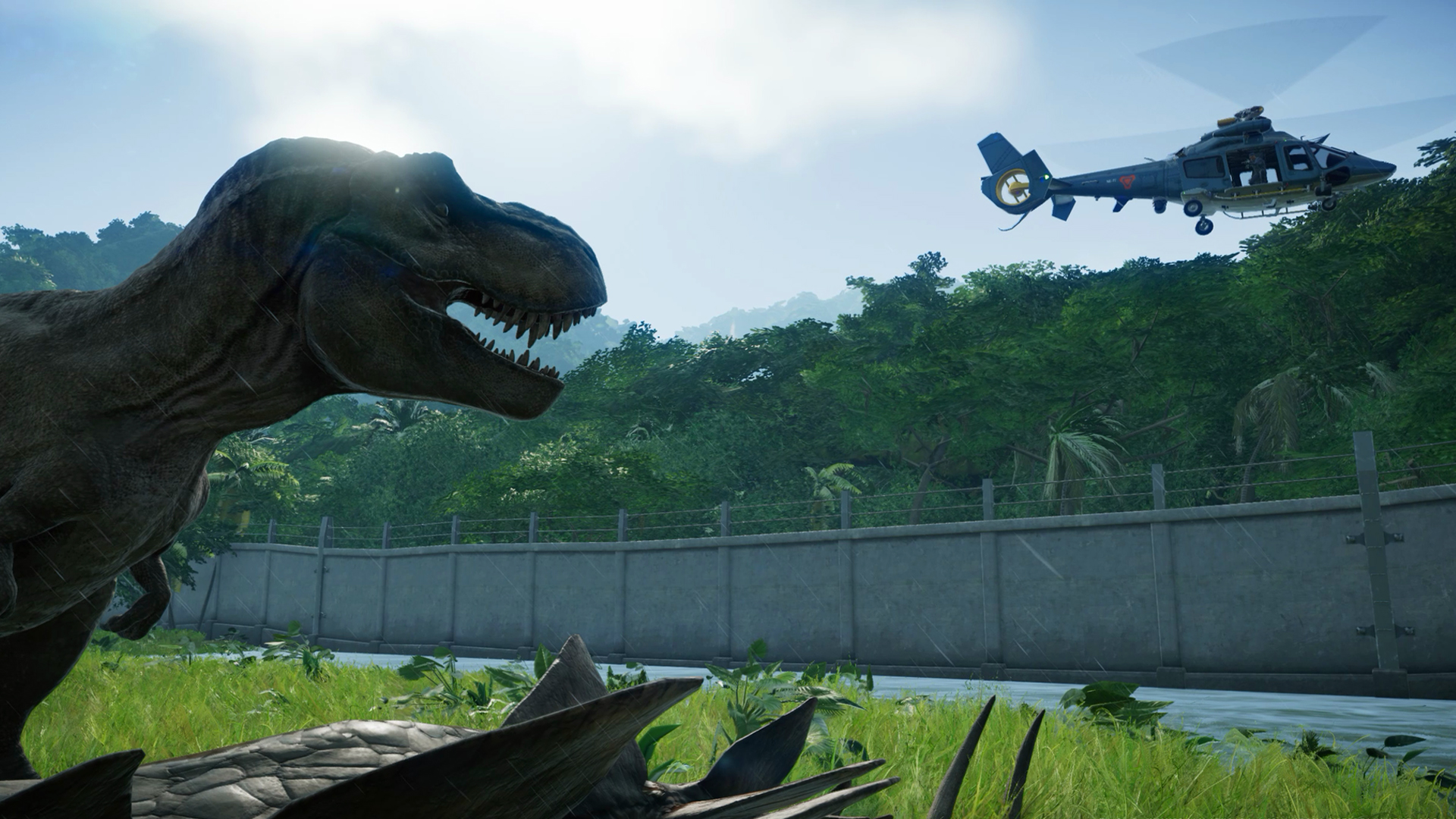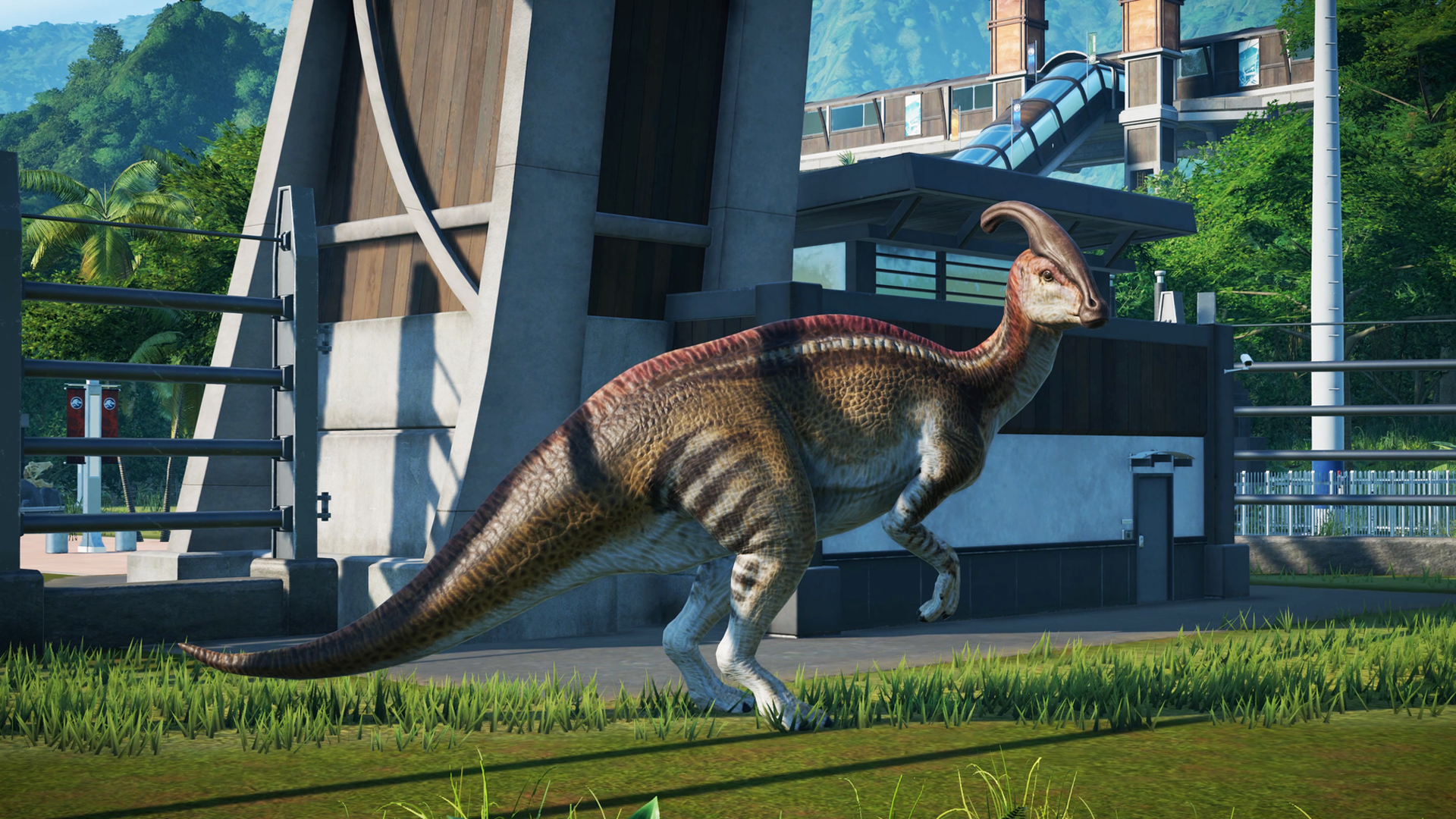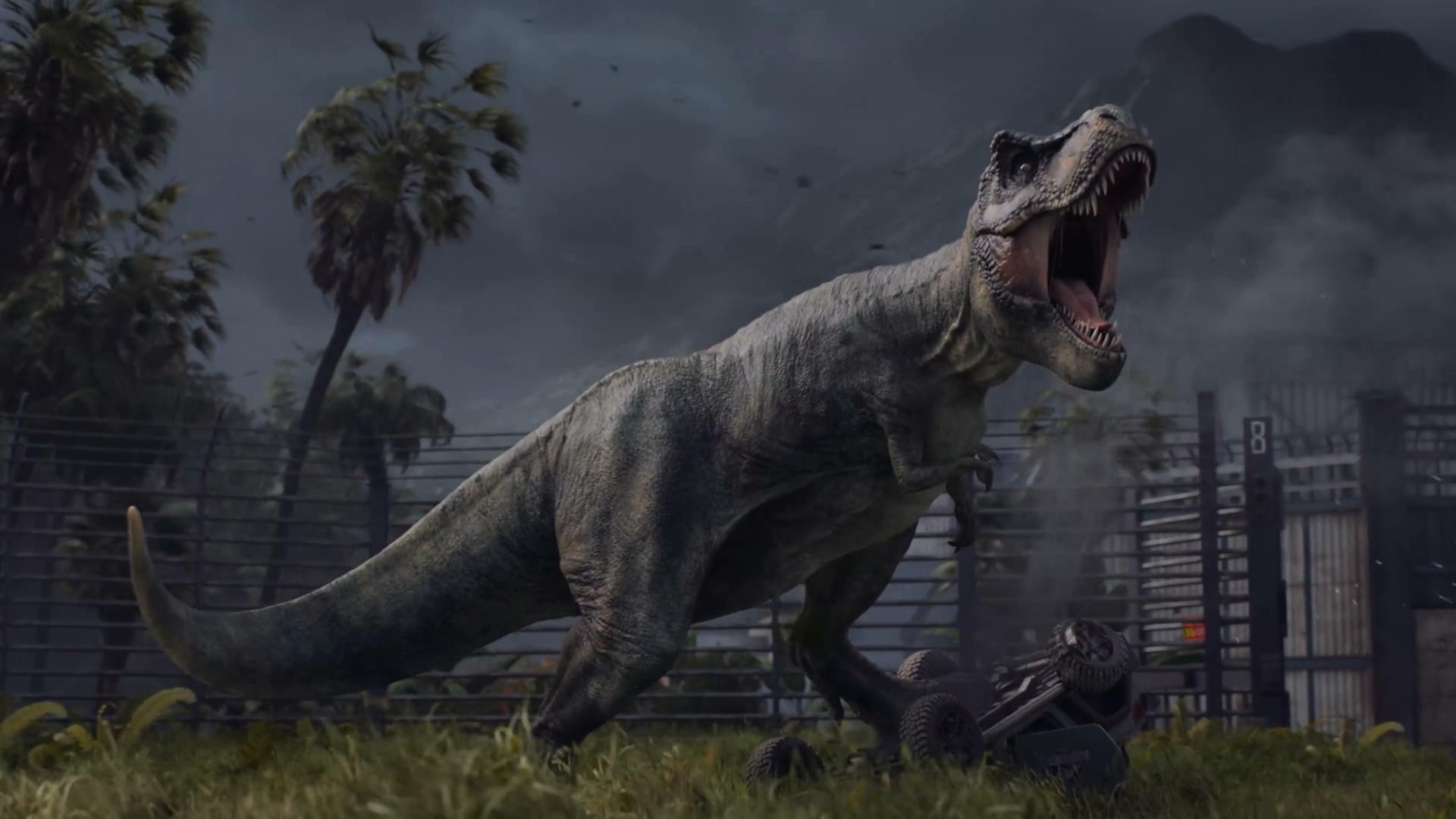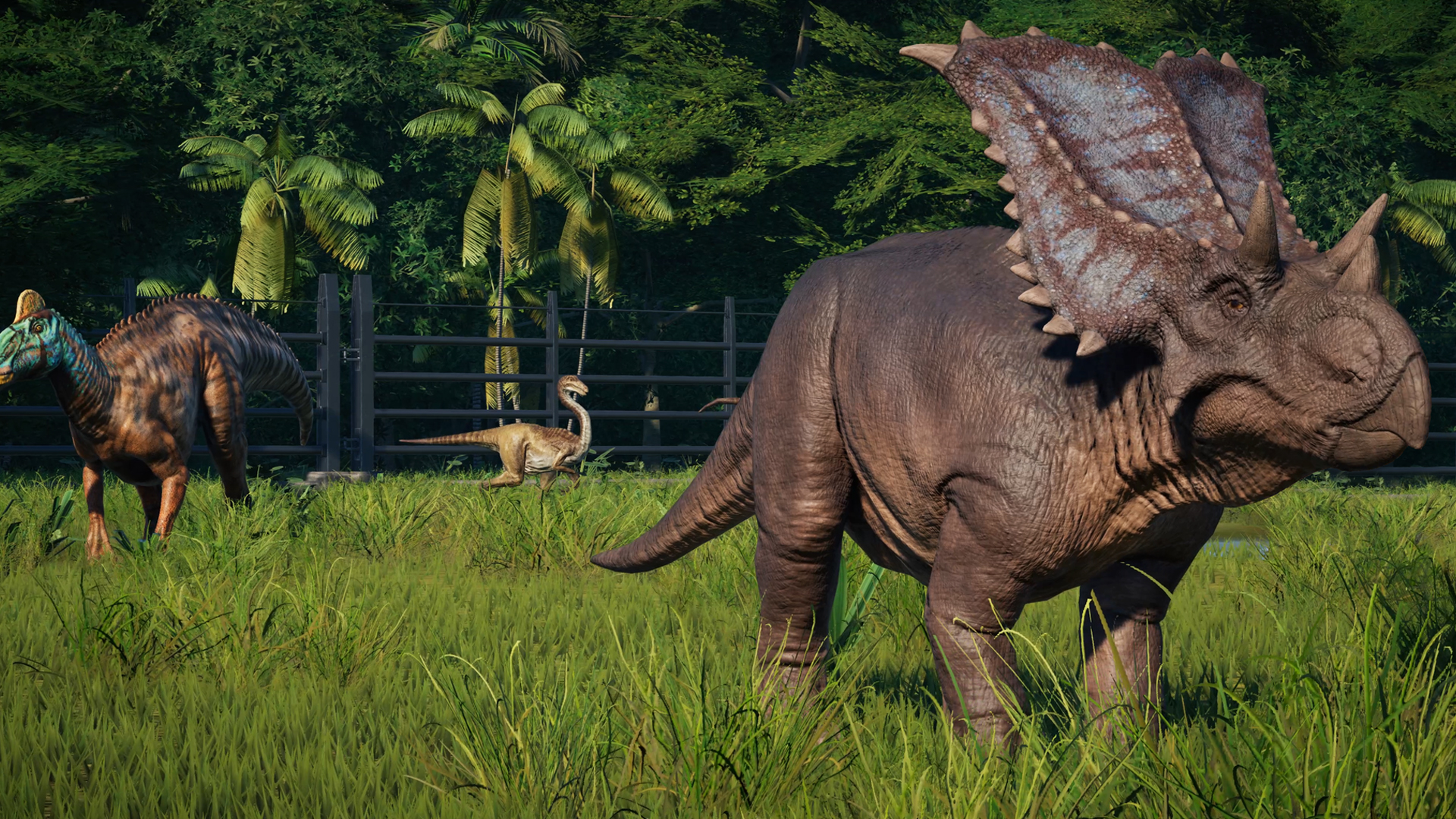Jurassic World Evolution: Build your own park, farm custom dinosaurs, pull out the tranq gun when it all goes wrong

“Why don’t they just…?” It’s the most commonly uttered notion during the watching of any horror or disaster film. Because you, the audience, always know better, don’t you? “Why don’t they just not go into the basement? Why don’t they just build better security around the dangerous thing? Why don’t they just not do any of the things that led to all of this in the first place?”
Well guess what, buddy. You’re about to find out. Because in Jurassic Park: Evolution, you can now take direct control of the most inevitably disaster-prone enterprise in modern sci-fi cinema history, and find out the answer for yourself. Because now the ‘they’ is you, and you no longer have the advantage of smug detachment. What you do have, though, is some really large dinosaurs and a lot of small, hot dog munching punters, separated by a relatively thin fence. Good luck with that. It’ll probably be fine.
Humble beginnings, potentially messy ends
A theme park management sim from Frontier Developments - creator of 2016’s brilliant Planet Coaster and a whole bunch more of the genre’s most important games, dating back to 2003 – it’s clear from an initial glance at Evolution’s systems that the game takes things seriously. Not content to smear licensed gloss over a lightweight genre approximation, Jurassic World Evolution, despite being as friendly and welcoming as any real theme park should be, quickly makes me very aware that I have work to do.
Starting out, I have access to a small array of fields, a genetic research lab, and very little else. InGen is bankrolling this park, but I have a limited budget, and so balancing the books is going to be vital. Unlike certain Jurassic Parks throughout history, this one is actually going to open and operate as a business, and so run as a business it must. Even if I have to temporarily cut corners from time to time. But only for the greater good, you understand. It’ll probably work out just fine.
Realising that I currently have something more akin to a Sad Lizard Petting Zoo than a Jurassic World, I need to expand. My solitary Sad Lizard (a herbivore Struthiomimus in this case) is getting sadder, and needs a friend. I know this because all of my dinosaurs have individual stats for personality traits and needs, because dinosaurs are people too goddamnit, and if man is not going to turn out to be the real monster yet again, I must tend to those needs.

There are multiple, dynamically changing statistics to manage on each dinosaur, from satisfaction with habitat, socialisation, and food availability, to genetic authenticity, resilience, and notoriety. That latter issue concerns things like a dinosaur’s aggression, ferocity, and kill-count, with a higher rating making for a trickier inmate, but a bigger attraction and faster ticket sales. Obviously if you were an entirely good person you’d keep that number low, and dinosaur life peaceful and harmonious. But you’re in InGen employee feeling pressure from the corporate overlords, so it might not work out that way long-term. Already, Evolution is blending several of the movie series’ key themes neatly into gameplay mechanics. Life might find a way, but irresponsible, profit-hungry assholes tend to as well.
Anyway, right now I want to boost my dino’s Social stat, so I engineer a second Struthi and let them make friends. I rename one of them Megachicken, because that’s a thing you can do, and then I leave them to it. I now have a less-Sad Lizard Petting Zoo, with two whole lizards. Mercifully though, here comes my Entertainment manager with an opportunity. Enter, the main structure of Jurassic World: Evolution, which involves branching missions and objectives offered by the bosses of the park’s three core pillars: Science, Security, and the aforementioned Entertainment.
Weekly digests, tales from the communities you love, and more
Give the people what they want

At this early stage, I’m tasked with setting up some of the basic tools of my park’s development, by building an Expedition Center, from which I can launch worldwide fossil digs in order to find more and better DNA samples with which to expand and upgrade my roster of available dinosaurs. Again, better, more authentic dinos mean more visitors, though later I’ll be able to make hybrids to emphasise desirable, crowd-pleasing traits. Building a new facility in Evolution is as easy as having the space (forest can be cleared if needed), connecting it up to the power grid (more power stations will be required as the park expands), and having the funds to build it in the first place (your mileage will vary). In this case everything is on point, so I place the Expedition Center and send a chopper off to find something new to make.
Not long after, I have enough DNA (each dino species needs at least a 50% genome before it can be created) to make that new thing. I decide on a distinctly less herbivorous Ceratosaurus, and here, friends, is where shit gets real. And I’m not just talking about the severity of my situation. Jurassic World: Evolution is a distinctly more hands-on business sim than you might be expecting.

Tracking my Ceratosaurus (codename: Bitey) as she stomps out of the lab into the compound, she’s an unmistakably ferocious beasty. Evolution is very careful to never let its necessarily zoomed-out viewpoint lose sight of the real appeal of franchise. As such, it includes a dino-cam, which pulls my point-of-view down to a human-height perspective orbiting any ‘saur I click on, for the full, immersive, ‘Holy crap, that really is big’ experience. And Bitey is big. I watch her decidedly heavy awe and majesty clump angrily across the paddock for a moment, with the kind of bogglingly lifelike animation that makes one really glad this game isn’t in VR. And then I notice something. Bitey has stopped, and just out of the corner of her dino-cam, I can see the tail of one of my Struthis.
Shit.
I zoom out with fevered abandon, flailing at the side-bar menu for a solution to the problem, but before I can click on anything, the two dinos have become one, and I’m back down to a single Struthiomimus. While I didn’t get time to check, I can only assume that Bitey’s food stat has improved, so at least there’s that silver lining. But I need to take hold of this situation quickly.
Turoking all over the world

Having built a ranger station in preparation for my first carnivore (I’m not naïve), I send a response unit into action. Or rather, I go into action myself. Because while I can let the process play out on its own, relying on AI to deal with the problem, I can also handle it manually, via first-person, real-time action. And why the hell would I not? Aside from not having to trust tiny, faceless computer people to keep my park afloat, facing down the dinos, er, face-to-face makes Evolution a far more layered, meaningful, tangibly Jurassic World experience. Because the Jurassic movies aren’t just about the failings of park infrastructure. They’re about the horrible, teeth-gnashing reality of what happens when the system does fail. I love that Evolution steers into that.
So I launch a chopper, and I pilot it over to the compound, praying with each second that there’s still more than one dinosaur left when I get there. Mercifully, there is, and Bitey is looking rather chilled, much to my heavy-sighing, chair-slumping relief. She’s hanging out on the other side of the paddock to Megachicken (thankfully the Struthi I named, and therefore care about more, survived the initial attack). She’s kicking back by the water, distractedly having a drink. I’m suddenly really glad I dug that lake earlier. Thank God for lakes. Lovely, splashy bastards.

Switching to suppression mode, I gain an FPS view as I hang out of the side of the hovering chopper, training a wobbly tranquiliser rifle at Bitey. But even with myself and my quarry (relatively) stationary, this is no simple point-and-shoot solution. Dart guns are weak as all heck, and I have to compensate for a whole lot of drop-off when calculating my shot trajectory. Regardless, I somehow send a dart home in a couple of shots. But I need two to drop something as big as Bitey, and now I’ve disturbed her. And, like human, like dinosaur, it turns out that sometimes, drugs make people hungry. She’s suddenly noticed Megachicken, and she’s on the move.
Swinging the helicopter in panic, I give chase, wildly throwing darts as she thunders across the grass. All of them miss, and Bitey is not slowing down. 30 feet. 20 feet. 15 feet. Megachicken still has no idea what’s charging toward her, terrified, flailing, airborne human in tow. Trigger finger and half-closed eyes tensed in unison, I launch a final, desperate salvo and, miraculously, one of the shots catches Bitey’s tail. She crumples. She stumbles. She skids down the small hill in front of her and slides unconscious to a halt just behind a still-oblivious Megachicken. I have won. Just about. Barely. Pretty much by accident. With only minor fatalities. As such, the incident is about as authentically Jurassic as it gets.
So what did we learn from this?

A minute later, I’m back in my detached, God’s-eye view, managing menus as I watch an AI transport chopper fly the slumbering Bitey over to the new enclosure I’ve built for her. But my perception of running a Jurassic World has changed a lot, since having to deal with even such a minor fallout first-hand. And I now have much greater sense of the weight of my future decisions.
That time I temporarily shut down power to the lab, because I need to build a souvenir shop and can’t afford another generator until my next DNA expedition (hopefully) delivers me a more profitable new exhibit? It feels an innocent cheat at the time, but what about when my park’s five times the size and I have to decide how many ranger stations to close in order to power that big, new-season enclosure I’m banking on to see me through for the year? The one containing the really angry, aggressive hybrid I’ve made, and surrounded with audience viewing stations to maximise crowd hype. The one I’ve conditioned to be angry enough to be a draw, but (probably) not angry enough to attempt an escape.
It’ll probably be fine. I’m sure nothing will go wrong. It’s bound to be fine, right? I’m already starting to understand why people in disaster movies do the things that they do, after all…
Think you can do better? Try our Jurassic World Evolution tips and see if life finds a way around you!



